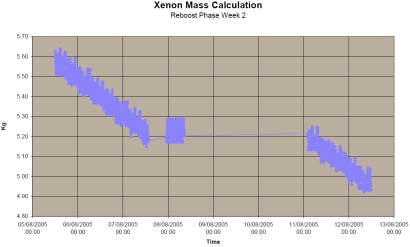No. 42 - Ion Drive Restarted
The critical point of 1.8 Kg of Xenon will be achieved during the first week of September when special procedures will be implemented. The tests done with the simulator have predicted a transition to under-regulated thrust at a remaining xenon level of 0.73 to 0.78 kg (depending upon temperature).
The EP operations are planned to last until mid September assuming simulator behaviour. The second half of September has been reserved for possible special operations in case the engine does not behave as expected.
Future Activities
- EP orbit re-boost operation in August and September
- Start work for next phase of ground automation activities
- SMART-1 Presentations in international conferences:
| SMART-1 Operations | Fukuoka, Japan | 17-21 October |
| Operationally Enhanced Electric Propulsion Performance on Electrically Propelled Spacecraft | Princeton,USA (TBC) | 1 November |
| SMART-1 Lunar Mission: Operational experience with its Automatic Attitude and Orbit Control Subsystem and its relation with Electric Propulsion System | Loutraki, Greece | 17-21 October |
| SMART-1 Lunar Mission: Startracker Operations Experience | Loutraki, Greece | 17-21 October |
| SMART-1 Lunar Mission: Reducing Mission Operations Costs | Kyoto, Japan | 11-13 October |
Spacecraft Status
AOCS
The AOC subsystem has done well in the period covered by this report.
Electric Propulsion, Power and Thermal
The re-boost phase has started during the reporting period. EP, Power and Thermal subsystems were working well. Due to the season effect, the re-boost phase started close to the maximum spacecraft to Sun distance, it means, close to the point of lower solar array power generation.
EP activities have re-started on 2 August. The Flight Dynamic strategy consists in 2 pulses per orbit of 68 minutes each. During this period, the FlameOut Monitoring is only enabled approximately half of the pulse duration. It is switched on just 3 minutes after the expected regular thrust event and it is disabled 35 minutes before the expected end of the pulse. The reason of that is to avoid an automatic recovery action that could be executed after the power off commanded by Flight Dynamic.
The following plot corresponds to the called Re-boost Phase Week 1: 2 Aug 10:00:00 – 5 Aug 12:00:00.
 |
The following plot corresponds to the called Re-boost Phase Week 2: 5 Aug 12:00:00 – 12 Aug 12:00:00). Note that due to problems in rerouting some data is missing. EP was off from Aug 8th until August 11th.
 |
Orbital Information
Due to the firing of the ion engine the orbit of SMART-1 is constantly changing. Two snapshots are provided on 8 August and 15 August.
Orbit for 8 August
|
SMART-1 OD342 – Close to Apolune 1013 | |
| Pericentre Distance (km) | 2163.053106 |
| Apocentre Distance (km) | 4650.306859 |
| Semi Major Axis (km) | 3406.679983 |
| Eccentricity | 0.365055 |
| Inclination (°) | 89.969852 |
| Ascending Node (°) | 237.563641 |
| Argument of Pericentre (°) | 252.925140 |
| True Anomaly (°) | 179.717592 |
| Osculating Orbital Period (h) | 4.956239 |
The changes since apolune 979 are as follows:
- Semi-major axis: +4.1 km
- Perilune height: -7.4 km
- Apolune height: +15.5 km
- Orbital period: +0.5 min
Orbit for 15 August
|
SMART-1 OD345 – Close to Apolune 1047 | |
| Pericentre Distance (km) | 2147.667749 |
| Apocentre Distance (km) | 4675.530762 |
| Semi Major Axis (km) | 3411.599256 |
| Eccentricity | 0.370481 |
| Inclination (°) | 90.285959 |
| Ascending Node (°) | 237.610355 |
| Argument of Pericentre (°) | 259.553885 |
| True Anomaly (°) | 179.899028 |
| Osculating Orbital Period (h) | 4.966978 |
The changes since apolune 1013 are as follows:
- Semi-major axis: +4.9 km
- Perilune height: -15.4 km
- Apolune height: +25.2 km
- Orbital period: +0.6 min
